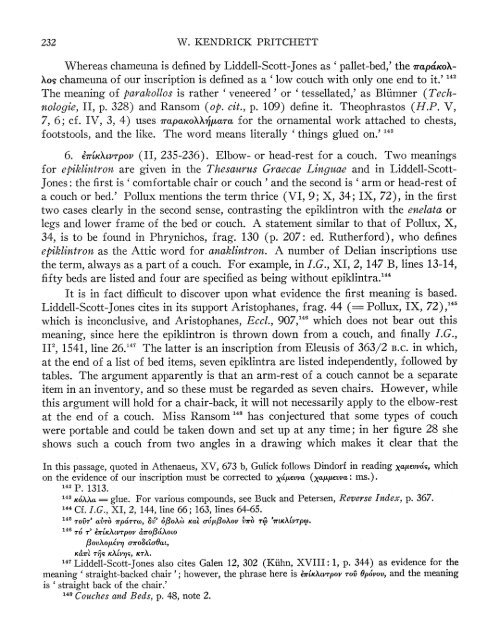the attic stelai - The American School of Classical Studies at Athens
the attic stelai - The American School of Classical Studies at Athens
the attic stelai - The American School of Classical Studies at Athens
Create successful ePaper yourself
Turn your PDF publications into a flip-book with our unique Google optimized e-Paper software.
232 W. KENDRICK PRITCHETT<br />
Whereas chameuna is defined by Liddell-Scott-Jones as ' pallet-bed,' <strong>the</strong> Irapa6KoX-<br />
Xos chameuna <strong>of</strong> our inscription is defined as a 'low couch with only one end to it.' 142<br />
<strong>The</strong> meaning <strong>of</strong> parakollos is ra<strong>the</strong>r 'veneered' or 'tessell<strong>at</strong>ed,' as Bliimner (Technologie,<br />
II, p. 328) and Ransom (op. cit., p. 109) define it. <strong>The</strong>ophrastos (H.P. V,<br />
7, 6; cf. IV, 3, 4) uses wrapaKoXXijapra for <strong>the</strong> ornamental work <strong>at</strong>tached to chests,<br />
footstools, and <strong>the</strong> like. <strong>The</strong> word means literally 'things glued on.' 143<br />
6. EITLKXtvITpOV (II, 235-236). Elbow- or head-rest for a couch. Two meanings<br />
for epiklintron are given in <strong>the</strong> <strong>The</strong>saurus Graecae Linguae and in Liddell-Scott-<br />
Jones: <strong>the</strong> first is 'comfortable chair or couch' and <strong>the</strong> second is 'arm or head-rest <strong>of</strong><br />
a couch or bed.' Pollux mentions <strong>the</strong> term thrice (VI, 9; X, 34; IX, 72), in <strong>the</strong> first<br />
two cases clearly in <strong>the</strong> second sense, contrasting <strong>the</strong> epiklintron with <strong>the</strong> enel<strong>at</strong>a or<br />
legs and lower frame <strong>of</strong> <strong>the</strong> bed or couch. A st<strong>at</strong>ement similar to th<strong>at</strong> <strong>of</strong> Pollux, X,<br />
34, is to be found in Phrynichos, frag. 130 (p. 207: ed. Ru<strong>the</strong>rford), who defines<br />
epiklintron as <strong>the</strong> Attic word for acnaklintron. A number <strong>of</strong> Delian inscriptions use<br />
<strong>the</strong> term, always as a part <strong>of</strong> a couch. For example, in I.G., XI, 2, 147 B, lines 13-14,<br />
fifty beds are listed and four are specified as being without epiklintra.'44<br />
It is in fact difficult to discover upon wh<strong>at</strong> evidence <strong>the</strong> first meaning is based.<br />
Liddell-Scott-Jones cites in its support Aristophanes, frag. 44 (= Pollux, IX, 72) p45<br />
which is inconclusive, and Aristophanes, Eccl., 907,140 which does not bear out this<br />
meaning, since here <strong>the</strong> epiklintron is thrown down from a couch, and finally I.G.,<br />
II2, 1541, line 26.147 <strong>The</strong> l<strong>at</strong>ter is an inscription from Eleusis <strong>of</strong> 363/2 B.C. in which,<br />
<strong>at</strong> <strong>the</strong> end <strong>of</strong> a list <strong>of</strong> bed items, seven epiklintra are listed independently, followed by<br />
tables. <strong>The</strong> argument apparently is th<strong>at</strong> an arm-rest <strong>of</strong> a couch cannot be a separ<strong>at</strong>e<br />
item in an inventory, and so <strong>the</strong>se must be regarded as seven chairs. However, while<br />
this argument will hold for a chair-back, it will not necessarily apply to <strong>the</strong> elbow-rest<br />
<strong>at</strong> <strong>the</strong> end <strong>of</strong> a couch. Miss Ransom 148 has conjectured th<strong>at</strong> some types <strong>of</strong> couch<br />
were portable and could be taken down and set up <strong>at</strong> any time; in her figure 28 she<br />
shows such a couch from two angles in a drawing which makes it clear th<strong>at</strong> <strong>the</strong><br />
In this passage, quoted in A<strong>the</strong>naeus, XV, 673 b, Gulick follows Dindorf in reading xauEvvavs, which<br />
on <strong>the</strong> evidence <strong>of</strong> our inscription must be corrected to xa`jevva (xa,iuvvcva: ms.).<br />
142 P. 1313.<br />
143<br />
xo'Aa - glue. For various compounds, see Buck and Petersen, Reverse Index, p. 367.<br />
144<br />
Cf. I.G., XI, 2, 144, line 66; 163, lines 64-65.<br />
145 ' 'N 'V T& V3<br />
. K<br />
1TOVT avTo 7rparw 8v' o/w K<strong>at</strong> corv3ov vro p ' 7rLKXvTpW.<br />
146 7o T7 xtVTpOV IOarOXO<br />
/ ovXo/1Edvy uroStrO<strong>at</strong>,<br />
Kart<br />
T77)S KXLVrjS, KTX.<br />
147 Liddell-Scott-Jones also cites Galen 12, 302 (Kuhn, XVIII: 1, p. 344) as evidence for <strong>the</strong><br />
meaning ' straight-backed chair'; however, <strong>the</strong> phrase here is W'cXvKAtvpov ToVi Opo'vov, and <strong>the</strong> meaning<br />
is ' straight back <strong>of</strong> <strong>the</strong> chair.'<br />
148 Couches and Beds, p. 48, note 2.
















